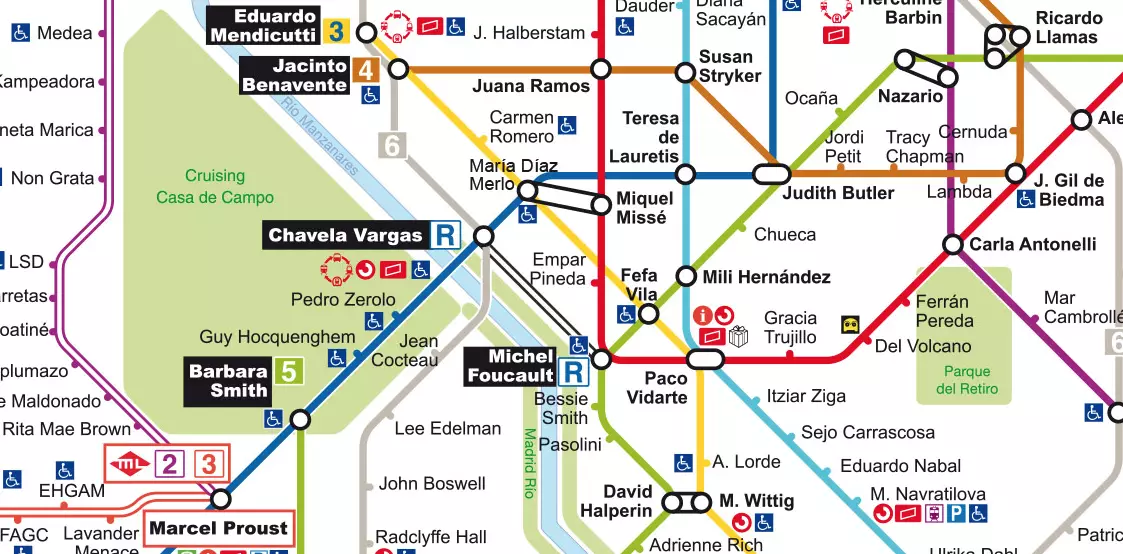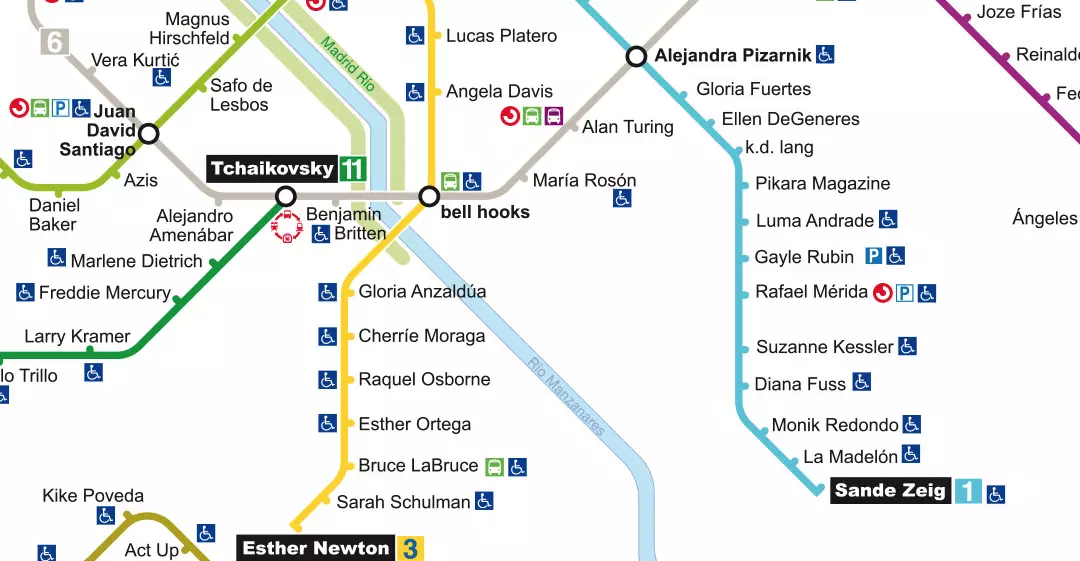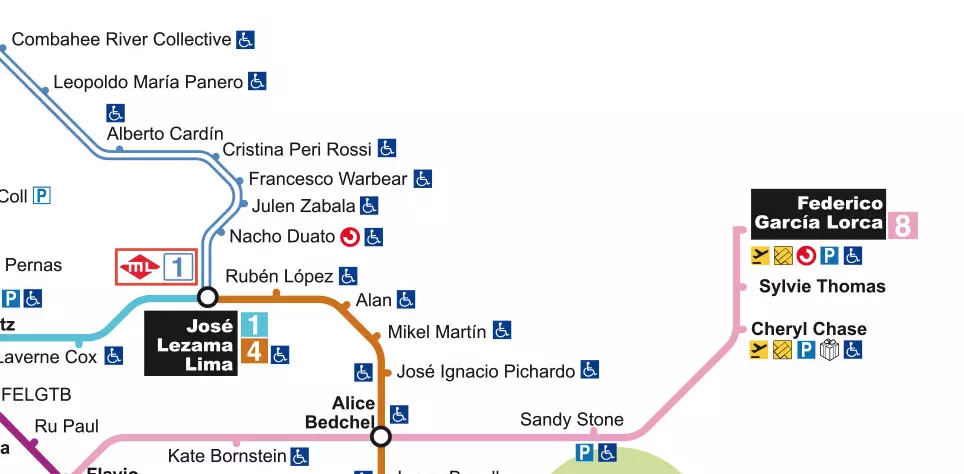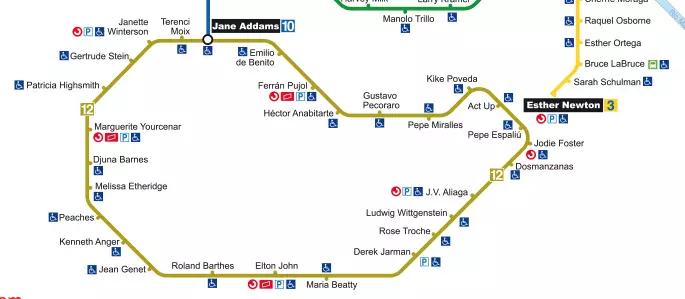
A Madrid metro map rescues LGBTIQ memory
The idea arose from such a daily gesture as looking at the subway map. "I realised that I couldn't find any reference to my community, the LGBTI and queer community . Despite seeing hundreds of stalls before me, there was no LGBTI person or reference, ”writes Javier Sáez on his blog.
“Let's say that I felt in a very heterocentric territory, that is, in what I usually call a 'heterritory'. And I think: What if we faggot, bollerized, transgendered, queerized the Metro? ”, he sentences.
His map is a personal representation, a topology of affects. Your way of saying we are and we are . “We do not have public spaces where the LGBTI struggle is discussed, of people who have been fighting for 30 years or more, fighting, being persecuted or taking risks for equality . We are not talked about in the educational system, nor in the media, nor in the history books. Y it is important for LGBT youth to see that they are not alone , let them see that sexual diversity is a reality and has always been”, Sáez explains to Traveler.
Each stop, each name, is part of his personal history, a tribute to the people from whom he has learned "almost everything he knows" after 30 years of activism . And although he acknowledges that his generation has marked him, he was born in Burgos in 1965, he also collects the work of young activists.
Bars, fanzines, places where these activists met, "friends" who have died of AIDS or transphobic violence, emerge in each station.

LGBTIQ Metro Map
EDUCATE IN DIVERSITY
His map is political genealogy. Do you think this map could be taught in schools? "Yes absolutely. I think it is a very useful and fun teaching tool : depending on which lines or stops you choose, you can explain the queer movement, the AIDS crisis, lesbian, gypsy or trans activism, the 80s, or the 90s or the present, the LGBT intellectual referents of Western history ( Wilde, Tchaikovsky, Barthes, Foucault, Djuna Barnes, Monique Wittig, Chavela Vargas, etc.)”, he replies without hesitation.
After decades of commitment as an activist and technical expert in the Department of Equality and Fight against Discrimination of the Fundación Secretariado Gitano, Javier Sáez sets his sights on the present and future generations.
“ There is a lack of education on sexual diversity in schools , and in addition, gay, lesbian, trans boys and girls could know referents, see that they are not alone but that we are thousands, millions . And straight boys and girls would better understand diversity and its richness,” he adds.

LGBTIQ Metro Map
THE NAMES THAT MAKE (THE) HISTORY
We ask him to introduce us to three of his protagonists and why he has chosen them:
- “ Paco Vidarte : he was a brilliant thinker and a great person, he was my best friend, and unfortunately he passed away from AIDS 9 years ago. He was a huge loss to me, to LGBT activism, and to philosophy. Their queer ethics It is the best book ever written on LGBT politics.”
- “ Fefa Villa , because she is a very committed feminist, lesbian and queer activist, someone of incorruptible honesty and a reference for the lesbian movement since the 90s. Also because she teaches me every day the need to support feminism and to be a feminist ”.
- “ Sonia Rescalvo , transsexual woman who was murdered by a group of Nazis in 1991. It is essential to remember the victims of transphobia , and the difficult situation that transsexual people still live in our country”.

LGBTIQ Metro Map
The map can be seen exposed in large size in CentroCentro _(Plaza de Cibeles) _ from June 22, 2017 to October 1 , as part of the #elporvenirdelarevuelta project and will be available at the Berkana bookstore _(Calle de Hortaleza, 62; Madrid) _ while supplies last.
Download the full map here.
TRANSSEXUALITY: PROGRESS AND CHALLENGES
“I think the most important thing that has happened is the emergence of a growing social consciousness , more and more numerous, that people deserve to have sexual and reproductive rights . Transsexuality is becoming more visible, and most importantly, discrimination against LGBTQ people is wrong, outdated and a crime ”, tells Traveler one of the protagonists of the map, Lucas Platero , Doctor in Political Science and Sociology, degree in Psychology. “I see that younger people know what the non binary identity , that live with fellow lesbians, bisexuals, trans... and that we have to live up to their needs”, he adds.
the author of Queer barbarisms and other esdrújulas believes that the main demands of the transsexual group in Spain go through the depathologization of transsexuality: “it is the main demand, to be able to receive social, health and educational support that makes our lives possible, without stigmatizing us or putting us in a 'disaster drawer'”.
Despite its optimistic tone, it highlights the road that remains to be traveled: in the labor insertion and protection of the youngest. “We have pending that we dare to have active employment policies for those who have difficulty leaving school early, who have had difficulty staying in school labor market for being transsexual, having a pen or for other reasons linked to social discrimination ”, explains Lucas Platero, professor of socio-community intervention.
And he adds that bullying is still a pending issue, "on a par with serious social problems such as violence against women, which are unaddressed and have a very important impact on LGTBQ people."
Follow @merinoticias
